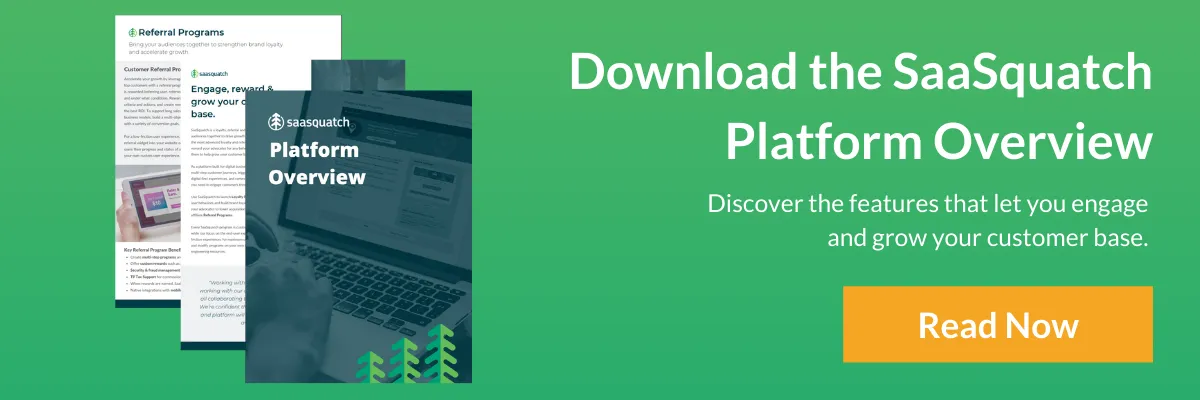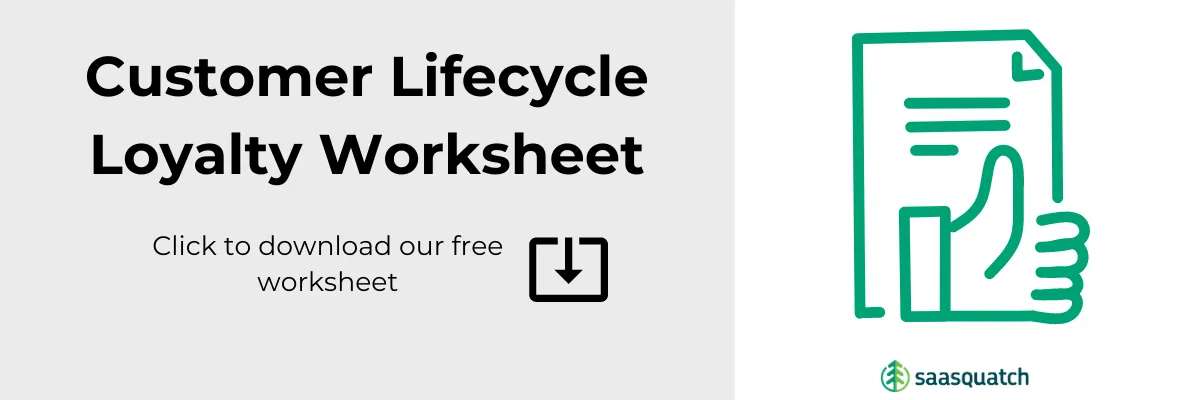The SaaSquatch Program Library: Your Secret Weapon for Growth
If you’re familiar with how customer loyalty programs boost lifetime value and lower acquisition costs, it might still leave you wondering “What’s the best customer loyalty strategy for my business?”
If you’re thinking it means giving points every time someone makes a purchase, you’re on the right track - but there’s so much more to it, and it doesn’t have to be complicated.
When you build a loyalty strategy using a diverse library of reward programs that appeal to multiple segments of customers, you create a unique user experience that boosts acquisition, engagement, and retention metrics.
That’s why we created the SaaSquatch Program Library: An extensive collection of loyalty, reward, and referral programs to help you engage every customer no matter where they are, and never miss a chance to grow.
Keep reading to learn what the library includes, plus how to apply it to your customer lifecycle for maximum conversions.
What is the SaaSquatch Program Library?
The SaaSquatch Program Library is the biggest collection of loyalty, reward and referral programs designed exclusively for digital businesses. It’s built specifically to help you engage prospects and customers in a complex online environment, enabling you to take advantage of multiple touchpoints and channels.
The library contains programs designed to help you:
- Acquire new customers,
- Shape customer behavior,
- Increase customer lifetime value,
- Drive customer referrals,
- Decrease customer churn,
- And more.
It includes programs like Referral Programs, Birthday Programs, Signup Programs, VIP Programs, Partner Programs, and much more.
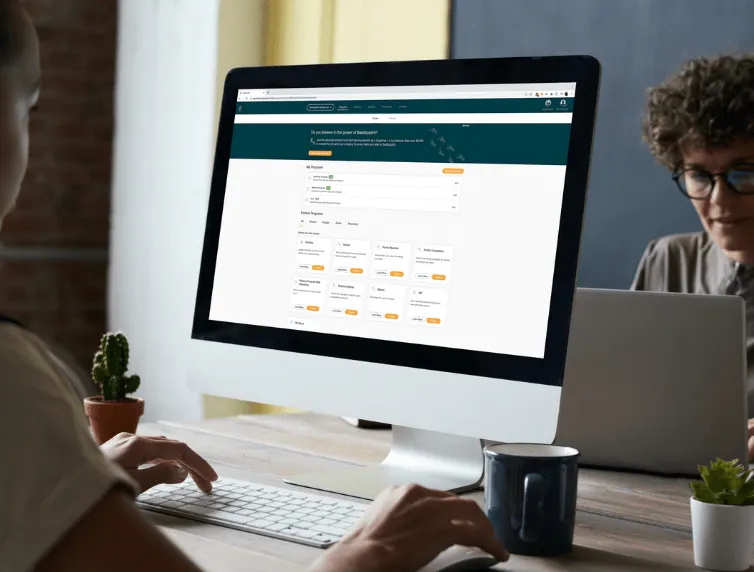
While the library contains pre-built programs including those pictured above, any program can be re-invented and customized to meet your needs. Alternatively, you can use the flexible rewards engine to start from scratch and build your own unique program based on your goals.
Download a summary PDF of the SaaSquatch Program Library to share with your team.
Why did we build the SaaSquatch Program Library?
When it comes to engaging your customers and building a profitable, scalable business, a successful loyalty strategy for a digital business involves more than just choosing one loyalty program and hoping it drives profit.
As we discuss in our online course, the Digital Loyalty Academy, the most effective approach involves designing and implementing multiple loyalty programs to work together, run alongside each other, and target every kind of customer, at every stage of their journey with your company.
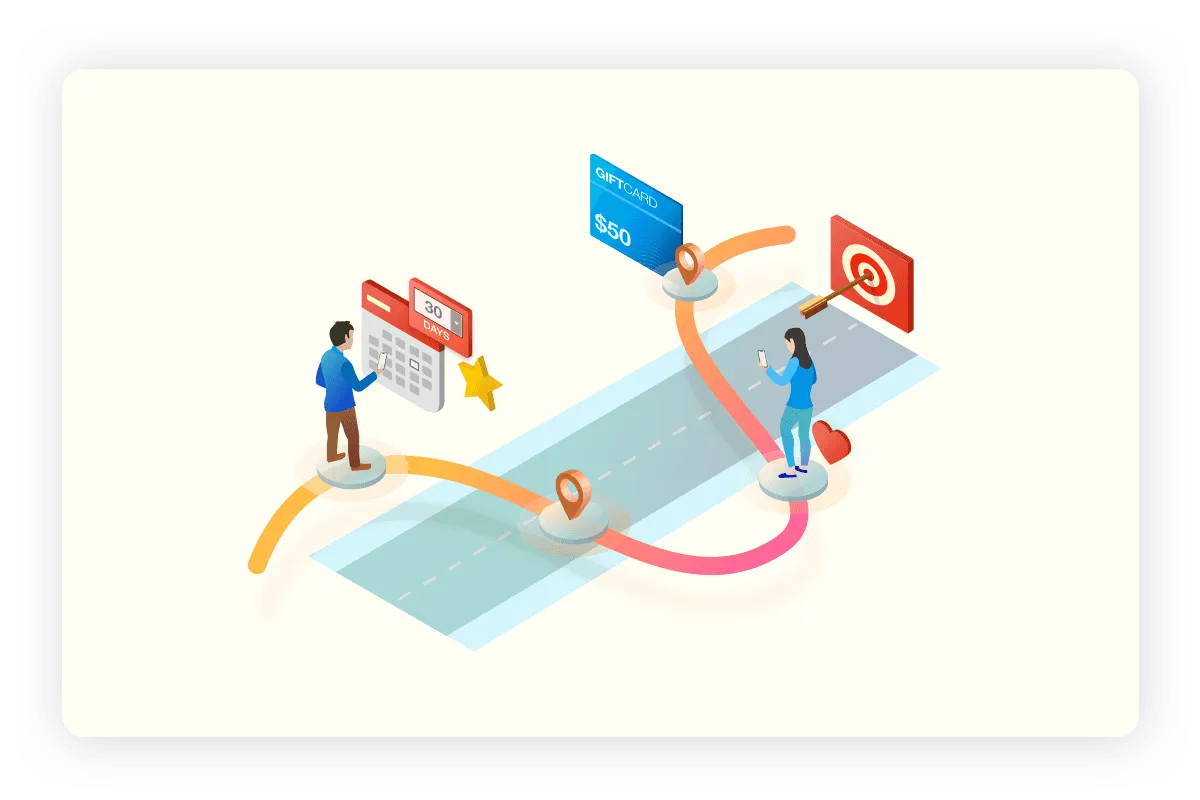
Why? As every customer moves through their journey with your product, they have varying levels of experience, knowledge, and commitment. A customer who just began a free trial shouldn’t be marketed to the same way as a customer who just renewed their 5th contract. This means that only offering one reward will only appeal to a specific subset of your customers, and not engage the rest.
This is why we built the program library: To let you deliver the right reward at the right time, to the right type of user. We created it for brands who are new to loyalty programs, and tailored it based on our experience helping our hundreds of customers reach new growth targets.
When you create different loyalty initiatives for your users based on where they are in the customer lifecycle, you have a better chance of meeting their unique needs and helping them develop into loyal brand advocates.
Plus, when increasing customer retention by 5% can increase profits from 25-95%, you’ll only benefit by making an effort to engage every subset of users.
Tip: If you’re new to the customer lifecycle and lifecycle marketing or would simply like a refresher, we encourage you to check out our post “What is Customer Lifecycle Marketing” for a full explanation of each lifecycle stage we’ll be using below.
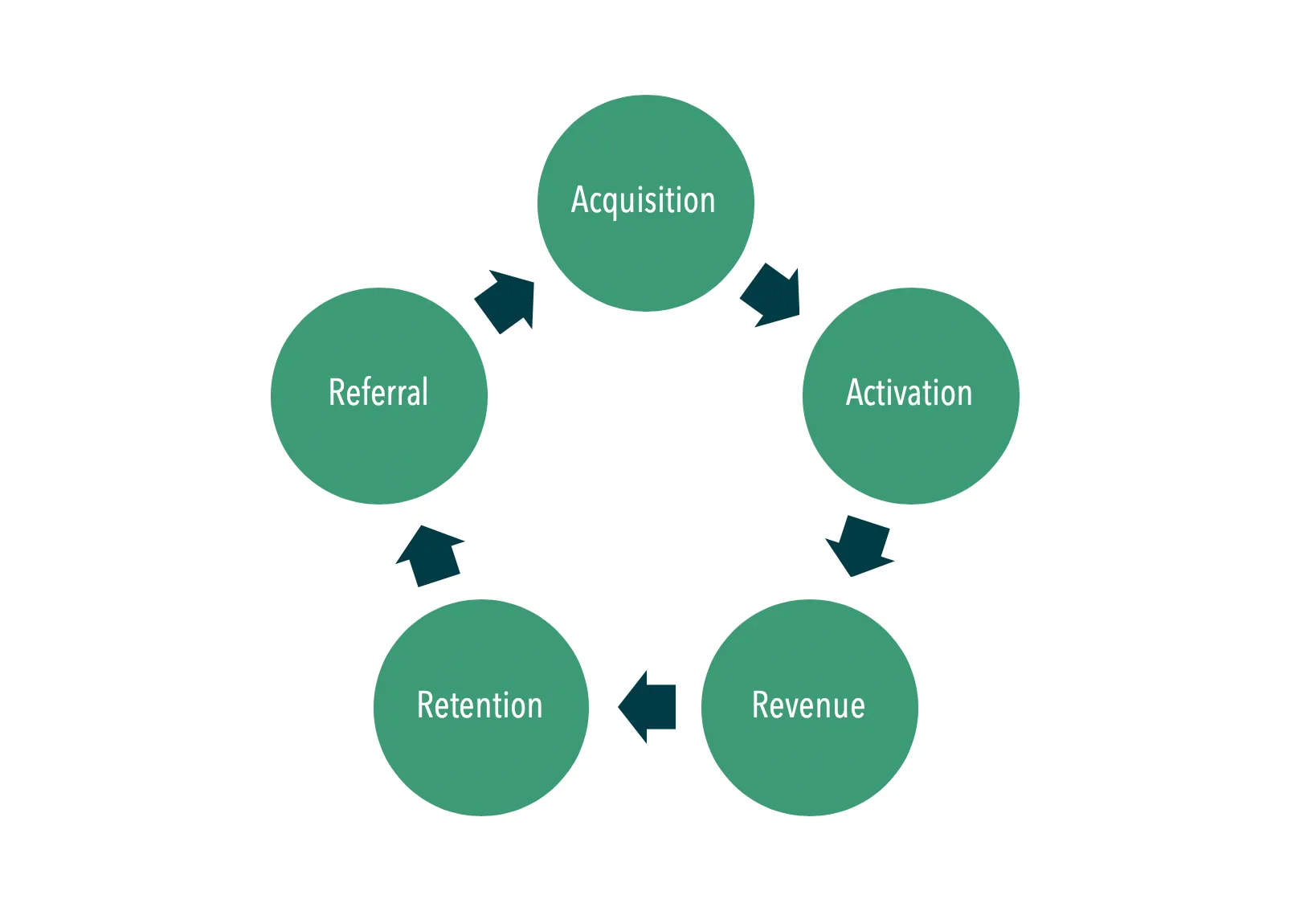
How can you use the SaaSquatch Program Library to drive growth?
While loyalty programs are traditionally only thought of as tactics for retaining customers, digital businesses are realizing that they can use rewards to meet a wide range of business goals. This is made possible by the amount of customer touchpoints they have compared to a brick & mortar business who must wait for a customer to enter the store.
This means that from the moment a prospect lands on your website, to the time they make their 50th purchase or renew their 4th subscription, you can engage them with a tailored rewards program as they grow with your brand.
For example, you can reward brand new customers for making their first purchase or customizing their account, and reward more mature customers for leaving a review, and so on.
Strategically applying specific loyalty, reward, and referral programs at each stage of the customer lifecycle, you create a complete strategy and don’t miss an opportunity to share your value proposition and keep customers coming back.
To lay this out in more detail, we’ve put together some examples on how a business would apply the SaaSquatch Program Library throughout their customers’ journeys.
For explanation purposes, our lifecycle model contains 5 stages: Acquisition, Activation, Retention, Revenue, and Referral.
While customer lifecycle models are known to have variation depending on industry, opinion, or business type, they all share the same concept of re-classifying users as they become more advanced product users and contribute more to your bottom line.
Example 1: How would a B2C Mobile Banking/Investing Application use the Program Library? (ie. Tangerine, Robinhood):
- Acquire: Provide special promotional offers and rewards for all new or existing customers who apply within a specified date range.
- Activate: Reward users when they complete specific behaviour for the first time such as funding an account and maintaining a specific balance, making a specific number of purchases or depositing their paycheque.
- Monetize: Reward users when they complete, or don’t complete, specific actions such as trying a newly launched feature, or making a credit card purchase after not making one for the last 6 months. Time limits can be imposed to create urgency.
- Retain: Make your customers feel special and better connected to your brand by rewarding them on their birthday or during their birth month. Rewards can be different based on customer segment and other data such as funds in account or active products.
- Refer: Reward existing customers for referring you to new customers. Provide referral bonuses and different rewards based on what products new customers purchase.
Sample rewards to use: Cash bonuses, special investing rates, gift cards, points, etc.
Example 2: How would a B2B CRM or Automation Software use the Program Library? (ie. Salesforce, Hubspot)
- Acquire: Reward users when they provide you with information such as personal contact info, preferences, goals or other valuable data. This program can require customers to provide multiple types of data before being rewarded.
- Activate: Reward users on a free trial when they complete specific behaviours for the first time such as using a feature, logging in a specific number of times, or completing an account set-up checklist
- Monetize: Provide special promotional offers for all new or existing customers who apply within a specified date range or who agree to an annual contract
- Retain: Reward accounts for adding additional user licenses to their contract.
- Refer: Reward existing customers for referring new or existing customers to apply for specific product offerings.
Sample rewards to use: Monthly discounts, exclusive account training, plan upgrades, gift cards, company swag, etc.
Download a summary PDF of the SaaSquatch Program Library to share with your team.
Exercise: Map rewards and loyalty programs to your customer lifecycle
With these examples in mind, it’s time to try it out for yourself and explore what the loyalty library can do for your business.
We’ve put together a simple exercise you can use to get a clear picture of how your users act at each stage of the customer journey, and then explore what kinds of rewards and loyalty programs would engage a user at this stage - download the blank worksheet template here!
Start by taking the time to map out a customer’s typical journey with your brand, from the moment they land on your website. Consider questions like:
- What action do you want them to do next?
- How can you help get them to the next stage in the lifecycle?
- What kinds of rewards and incentives will encourage them to stay engaged?
The important thing to remember is that the customer lifecycle is not finite. Keep it pictured in your mind as a continuous loop, with no hard barriers or strict paths that need to be followed.
Click here to download our blank worksheet template and fill out the boxes as they relate to your company’s customers, using the Program Library PDF as a reference guide. When you’re done, we’d love to see your ideas and help bring them to life - just get in touch!
When brainstorming, remember that the SaaSquatch rewards engine lets you set unique conditions for earning, create reward tiers, and offer a variety of different rewards to create the perfect custom programs - so get creative!
Let’s look at an example of the completed worksheet for ride-sharing company Uber:
| Customer Lifecycle Stage | What defines a user at this stage in your customer lifecycle? (what is their behavior at this stage?) | What kind of offer, reward, or loyalty program can you use to incentivize this kind of action? | Explain why this offer, reward, or loyalty program is relevant to a user at this stage. |
| Acquisition | A new user hears about Uber from a friend, and they decide to check it out on the app store and create an account. | When customers refer a friend, give both the existing and new customer $5 towards their next ride. Program: Referral Program | The new user is likely to trust a recommendation from a friend more than a marketing campaign from Uber. |
| Activation | The user checks the cost of getting a ride to their favorite restaurant, noticing that the price is significantly less than the taxi ride they usually pay for. | A welcome bonus (points or credit) for when the customer completes their profile and sets up frequent destinations in the app. Program: Signup/Behavioral Program |
The user will place more value in the app once they have spent time and effort customizing it. |
| Revenue | The user requests their first ride and submits payment for the service. | A VIP program that rewards users with exclusive rewards after they meet a certain threshold of rides. Program: VIP Program |
Once they achieve the top tier, users will be motivated to keep their exclusive social status and be less likely to switch to Lyft. |
| Retention | The user requests subsequent rides, and pre-loads money to be used for Uber Eats. | A win-back program offering a $5 credit incentive to those who haven’t requested a ride in one month. Program: Win-BackProgram |
Even if a customer has gone quiet, they’re still easier to sell to than a brand-new customer. They might need a small incentive to re-engage with the app again. |
| Referral | The user tells their friends about the great experiences they had with Uber, and recommend they try it out. | When customers refer a friend, give both the existing and new customer $5 towards their next ride. Program: Referral Program |
Having mechanisms in place to encourage customer referrals makes word-of-mouth marketing much more likely to occur. |
P.S. For more exercises and tips on building customer loyalty, enroll in the Digital Loyalty Academy for free today!
Ready to get growing?
If you’re considering applying the benefits of loyalty programs to your online business, we’re here to help you create the perfect strategy. If you’re ready to get growing, get in touch with us today to bring your ideas and goals to life.
To learn more about the SaaSquatch loyalty rewards platform click here, and don’t forget to download a summary PDF of the SaaSquatch Program Library to share with your team.
